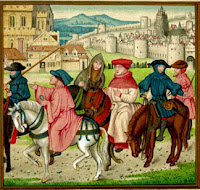British Lit Pardoner's Prologue & Tale - Plot Questions to Understand
This is to help you understand your reading, and to guide your note taking. This is not the homework questions for the blog. Scroll down to the next post for your homework blog posts for Monday!
Pardoner's PrologueRemember, this portion of the text is the Pardoner's conversation to the other pilgrims. This is part of the frame story not his tale within the frame!!! Think about why Chaucer would incorporate this little prologue.
1. What does his motto mean "Radix Malorum est cupiditas?" (know what covetousness means too!)
2. Why is it an ironic motto for the pardoner?
3. Make a note of things the pardoner does or says that makes him detestable to the audience.
4. What are some of the things the pardoner says he MUST have in his life? (page 321) What does this tell us about the Pardoner's character and Chaucer's view of pardoners?
Pardoner's Tale
5. Pardoner keeps repeating "look in the Bible" or "read it in the Bible." Why would he say that to the parishioners? (Think of who his audience is).
6. Pardoner begins his tale by introducing characters & their vices. Then he goes into a long winded speech about why these actions are vices. What are the actions and how does he justify that they are vices?
-- There are four. He picks the storyline back up on page 327.
7. Who is the villain that the "roisterers" are talking about? What makes him a villain?
8. What do they swear to do? What do they swear to each other?
9. Describe the old man in appearance and in attitude.
10. What do they find under the tree instead of the villain Death?
11. What is the original plan? What do the two brothers plan? What does the youngest brother plan on his way to town?
12. Pardoner turns to didactic language after the tale ends. What is his message? What is the hidden message (or not so hidden)?
13. How does the Host react to the Pardoner's Tale? What type of diction does he use to get his point across?
Analytical Questions to Consider:
What Deadly Sins are being committed here?What aspects of the tale are allegorical?
The deaths are anticlimactic in their tellings. Why?
What tactics at the end of this story does he employ to ensure that people buy pardons and/or relics?
Good luck & post questions here for classmates or myself if you are confused by a quote or plot point!








